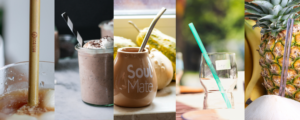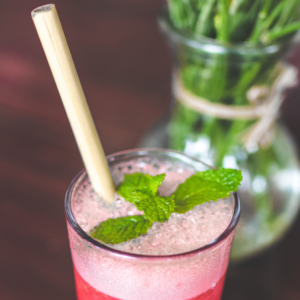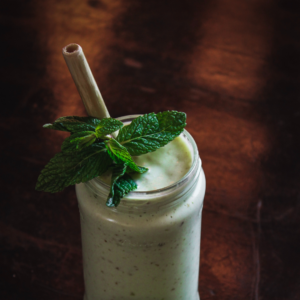
In honor of No Straw November, it’s time to talk about all the new alternatives to plastic straws that have started popping up. We’ve likely all heard about and possibly used the stainless steel straw, the paper straw, reusable plastic straws, and the silicone straw. So what’s new on the reusable/disposable eco-friendly straw front?
You can now find over 30 innovative alternatives to plastic straws, and we’ve pulled out the newest and most interesting alternatives. Just before we jump in, here’s a little history lesson/reality check excerpt from the straw section in our book (p. 145) describing why we need alternatives to plastic straws:
“From their first appearance going back to ancient Mesopotamia where Sumerians sucked in beer with straws made of gold and lapis lazuli, to today’s decidedly less glamorous and durable single-use straws, the plastic straw has become another symbol of our painfully destructive, throwaway culture.“
Sip Cup Lids:
Sip cup lids replace the need for a straw altogether. Most are degradable but unfortunately are not meant for backyard compost. They need to go to a commercial-grade compost facility and sometimes still end up in the landfill.
Plant-based Straws:
The most common plant straws are made from polylactic acid or PLA (a plant-based bioplastic). They are biodegradable and have pretty much the same drinking experience as a one-time-use plastic straw. But note that PLA straws are also biodegradable only in industrial composting facilities – not your backyard.
Bamboo Straws:
What’s great about bamboo straws is that bamboo is one of the most sustainable and fast-growing plant resources on earth. It’s naturally antibacterial, biodegradable, and generally chemical-free as pesticides and fertilizers are not required for its growth.
Ryegrass and Common Reed Straw:
Ryegrass (Lolium spp.) and Common Reed (Phragmites australis) Straws are two types of grass that are commonly grown in fields. They have actually been used as straws for centuries! Ryegrass was the initial blueprint for the plastic straw. You could probably find these grasses growing in a field near you OR if you have a green thumb, grow your own!
Papaya Leaf Stem:
If you live where Papaya grows you can always cut a fresh straw right from the plant. Just make sure that you rinse the straw end first, so you don’t have the taste of sap with your beverage.

Sugarcane Straw:
These straws are made from Sugarcane, making them 100% compostable (ok in the home composter for these ones!). They are durable and can be used for both hot and cold drinks. Sugarcane, just like bamboo, grows faster than trees, protecting our precious forests.
Edible Straws:
A company called Loliware has designed a straw from seaweed. These straws are 100% compostable and marine-biodegradable. Another of the cool things about these straws is that they can be eaten afterwards, and are gluten-free, sugar-free and non-GMO!
Final Thoughts:
It’s exciting when manufacturers begin to get innovative when thinking about replacing a plastic straw with a reusable or eco-friendly alternative. The next step is to start lobbying the big companies and restaurants to start offering and selling eco-friendly straws. No matter how many amazing replacements are created, the demand and adoption rate depend on those who sell them, and those who buy. So use your buying power wisely!
Want to read more? Check out some of our past posts about ditching the plastic straw:
OneLessStraw toward One More Generation
Who Needs Plastic Straws Anymore When We’ve Got These
A Single Straw For Life – Our Top 5 Favourites
Author: Sarah Atherton
